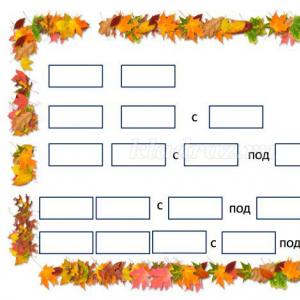Determine which line is determined by the equation to make a drawing. The concept of the line equation
§ 9. The concept of the equation of a line.
Define a line using an equation
Equality of the form F (x, y) = 0 is called an equation with two variables x, y, if it is not true for all pairs of numbers x, y. They say two numbers x = x 0 , y=y 0, satisfy some equation of the form F(x, y)=0, if when substituting these numbers instead of variables X and at in the equation, its left side vanishes.
The equation of a given line (in the assigned coordinate system) is such an equation with two variables, which is satisfied by the coordinates of each point lying on this line, and not satisfied by the coordinates of each point not lying on it.
In the future, instead of the expression "given the equation of the line F(x, y) = 0" we will often say shorter: given a line F(x, y) = 0.
Given the equations of two lines F(x, y) = 0 and Ф(x, y) = Q, then the joint solution of the system
Gives all their points of intersection. More precisely, each pair of numbers , which is a joint solution of this system, determines one of the intersection points.
1)X 2 +y 2 = 8, x-y = 0;
2) X 2 +y 2 -16x+4at+18 = 0, x + y= 0;
3) X 2 +y 2 -2x+4at -3 = 0, X 2 + y 2 = 25;
4) X 2 +y 2 -8x+10y+40 = 0, X 2 + y 2 = 4.
163. Points are given in the polar coordinate system
Determine which of these points lie on the line defined by the equation in polar coordinates = 2 cos , and which do not lie on it. What line is determined by this equation? (Show it on the drawing :)
164. On the line defined by the equation =  ,
find points whose polar angles are equal to the following numbers: a)
,
find points whose polar angles are equal to the following numbers: a)  ,b) - , c) 0, d)
,b) - , c) 0, d)
 . Which line is defined by this equation?
. Which line is defined by this equation?
(Build it on the drawing.)
165. On the line defined by the equation =  , find points whose polar radii are equal to the following numbers: a) 1, b) 2, c)
, find points whose polar radii are equal to the following numbers: a) 1, b) 2, c)  .
Which line is defined by this equation? (Build it on the drawing.)
.
Which line is defined by this equation? (Build it on the drawing.)
166. Determine which lines are determined in polar coordinates by the following equations (build them on the drawing):
1) = 5; 2) = ; 3) =  ; 4) cos = 2; 5) sin = 1;
; 4) cos = 2; 5) sin = 1;
6) = 6 cos ; 7) = 10 sin ; 8) sin =
An equality of the form F(x, y) = 0 is called an equation with two variables x, y, if it is not valid for any pair of numbers x, y. They say that two numbers x \u003d x 0, y \u003d y 0 satisfy some equation of the form F (x, y) \u003d 0, if when these numbers are substituted for the variables x and y in the equation, its left side vanishes.
The equation of a given line (in the assigned coordinate system) is an equation in two variables that is satisfied by the coordinates of every point lying on this line, and not satisfied by the coordinates of every point not lying on it.
In what follows, instead of the expression “given the equation of the line F(x, y) = 0”, we will often say shorter: given the line F(x, y) = 0.
If the equations of two lines F(x, y) = 0 and Ф(x, y) = 0 are given, then the joint solution of the system
F(x, y) = 0, F(x, y) = 0
gives all their points of intersection. More precisely, each pair of numbers that is a joint solution of this system determines one of the intersection points,
157. Given points *) M 1 (2; -2), M 2 (2; 2), M 3 (2; - 1), M 4 (3; -3), M 5 (5; -5), M 6 (3; -2). Determine which of the given points lie on the line defined by the equation x + y = 0, and which do not lie on it. Which line is defined by this equation? (Show it on the drawing.)
158. On the line defined by the equation x 2 + y 2 \u003d 25, find points whose abscissas are equal to the following numbers: 1) 0, 2) -3, 3) 5, 4) 7; on the same line, find points whose ordinates are equal to the following numbers: 5) 3, 6) -5, 7) -8. Which line is defined by this equation? (Show it on the drawing.)
159. Determine which lines are determined by the following equations (build them on the drawing): 1) x - y \u003d 0; 2) x + y = 0; 3) x - 2 = 0; 4)x + 3 = 0; 5) y - 5 = 0; 6) y + 2 = 0; 7) x = 0; 8) y = 0; 9) x 2 - xy \u003d 0; 10) xy + y 2 = 0; 11) x 2 - y 2 \u003d 0; 12) xy = 0; 13) 2 - 9 = 0; 14) x 2 - 8x + 15 = 0; 15) y 2 + by + 4 = 0; 16) x 2 y - 7xy + 10y = 0; 17) y - |x|; 18) x - |y|; 19) y + |x| = 0; 20) x + |y| = 0; 21) y = |x - 1|; 22) y = |x + 2|; 23) x 2 + y 2 = 16; 24) (x - 2) 2 + (y - 1) 2 \u003d 16; 25 (x + 5) 2 + (y-1) 2 = 9; 26) (x - 1) 2 + y 2 = 4; 27) x 2 + (y + 3) 2 = 1; 28) (x - 3) 2 + y 2 = 0; 29) x2 + 2y2 = 0; 30) 2x2 + 3y2 + 5 = 0; 31) (x - 2) 2 + (y + 3) 2 + 1 = 0.
160. Lines are given: l)x + y = 0; 2) x - y \u003d 0; 3) x 2 + y 2 - 36 = 0; 4) x 2 + y 2 - 2x + y \u003d 0; 5) x 2 + y 2 + 4x - 6y - 1 = 0. Determine which of them pass through the origin.
161. Lines are given: 1) x 2 + y 2 = 49; 2) (x - 3) 2 + (y + 4) 2 = 25; 3) (x + 6) 2 + (y - Z) 2 = 25; 4) (x + 5) 2 + (y - 4) 2 = 9; 5) x 2 + y 2 - 12x + 16y - 0; 6) x 2 + y 2 - 2x + 8y + 7 = 0; 7) x 2 + y 2 - 6x + 4y + 12 = 0. Find the points of their intersection: a) with the x-axis; b) with the Oy axis.
162. Find the intersection points of two lines:
1) x 2 + y 2 - 8; x - y \u003d 0;
2) x 2 + y 2 - 16x + 4y + 18 = 0; x + y = 0;
3) x 2 + y 2 - 2x + 4y - 3 = 0; x 2 + y 2 = 25;
4) x 2 + y 2 - 8y + 10y + 40 = 0; x 2 + y 2 = 4.
163. Points M 1 (l; π/3), M 2 (2; 0), M 3 (2; π/4), M 4 (√3; π/6) and M 5 ( 1;2/3π). Determine which of these points lie on the line defined in polar coordinates by the equation p = 2cosΘ, and which do not lie on it. What line is determined by this equation? (Show it on the drawing.)
164. On the line defined by the equation p \u003d 3 / cosΘ, find points whose polar angles are equal to the following numbers: a) π / 3, b) - π / 3, c) 0, d) π / 6. Which line is defined by this equation? (Build it on the drawing.)
165. On the line defined by the equation p \u003d 1 / sinΘ, find points whose polar radii are equal to the following numbers: a) 1 6) 2, c) √2. Which line is defined by this equation? (Build it on the drawing.)
166. Determine which lines are determined in polar coordinates by the following equations (build them on the drawing): 1) p \u003d 5; 2) Θ = π/2; 3) Θ = - π/4; 4) р cosΘ = 2; 5) p sinΘ = 1; 6.) p = 6cosΘ; 7) p = 10 sinΘ; 8) sinΘ = 1/2; 9) sinp = 1/2.
167. Construct the following spirals of Archimedes on the drawing: 1) p = 20; 2) p = 50; 3) p = Θ/π; 4) p \u003d -Θ / π.
168. Construct the following hyperbolic spirals on the drawing: 1) p = 1/Θ; 2) p = 5/Θ; 3) р = π/Θ; 4) р= - π/Θ
169. Construct the following logarithmic spirals in the drawing: 1) p \u003d 2 Θ; 2) p = (1/2) Θ .
170. Determine the length of the segments into which the Archimedean spiral p = 3Θ cuts the beam leaving the pole and inclined to the polar axis at an angle Θ = π / 6. Make a drawing.
171. Point C is taken on the Archimedean spiral p \u003d 5 / πΘ, the polar radius of which is 47. Determine how many parts this spiral cuts the polar radius of point C. Make a drawing.
172. On a hyperbolic spiral P \u003d 6 / Θ, find a point P, the polar radius of which is 12. Make a drawing.
173. On a logarithmic spiral p \u003d 3 Θ find a point P, the polar radius of which is 81. Make a drawing.
The most important concept of analytic geometry is equation of a line on a plane.
Definition. Equation of a line (curve) on a plane Oxy called an equation that satisfies the coordinates x and y each point of this line and do not satisfy the coordinates of any point that does not lie on this line (Fig. 1).
In general, the line equation can be written as F(x,y)=0 or y=f(x).
Example. Find the equation of the set of points equidistant from the points A(-4;2), B(-2;-6).
Solution. If M(x;y) is an arbitrary point of the desired line (Fig. 2), then we have AM=BM or

After transformations, we get
Obviously, this is the equation of a straight line. MD- perpendicular restored from the middle of the segment AB.
Of all the lines on the plane, of particular importance is straight line. It is a graph of a linear function used in the most common linear economic and mathematical models in practice.
Different types of equation of a straight line:
1) with slope k and initial ordinate b:
y = kx + b,
where is the angle between the straight line and the positive direction of the axis OH(Fig. 3).

Special cases:
- the line passes through origin(fig.4):

– bisector first and third, second and fourth coordinate angles:
y=+x, y=-x;
- straight parallel to the x-axis and herself OX axis(Fig. 5):
y=b, y=0;

- straight parallel to the OY axis and herself OY axis(Fig. 6):
x=a, x=0;

2) passing in this direction (with slope) k through the given point (Fig. 7) :
![]() .
.

If in the above equation k is an arbitrary number, then the equation defines bundle of straight lines passing through the point , except for a straight line parallel to the axis Oh.
ExampleA(3,-2):
a) at an angle to the axis OH;
b) parallel to the axis OY.
Solution.
a) ![]() , y-(-2)=-1(x-3) or y=-x+1;
, y-(-2)=-1(x-3) or y=-x+1;
b) x=3.
3) passing through two given points (Fig. 8) :
![]() .
.

Example. Write the equation of a straight line passing through the points A(-5.4), B(3,-2).
Solution. ![]() ,
,
4) equation of a straight line in segments (fig.9):
where a, b- segments cut off on the axes, respectively Ox and Oh.

Example. Write an equation for a line passing through a point A(2,-1), if this line cuts off from the positive semiaxis Oy a segment twice as long as from the positive semiaxis Ox(Fig. 10).

Solution. By condition b=2a, then . Substitute the coordinates of the point A(2,-1):
Where a=1.5.
Finally we get:
Or y=-2x+3.
5) general equation of a straight line:
Ax+By+C=0,
where a and b not equal to zero at the same time.
Some important characteristics of straight lines :
1) distance d from a point to a line:
![]() .
.
2) the angle between the straight lines and respectively:
and  .
.
3) condition of parallel lines:
or .
4) the condition of perpendicularity of lines:
or ![]() .
.
Example 1. Write an equation for two lines passing through a point A(5.1), one of which is parallel to the line 3x+2y-7=0 and the other is perpendicular to the same line. Find the distance between parallel lines.
Solution. Figure 11.

1) the equation of a parallel line Ax+By+C=0:
from the condition of parallelism ;
taking the coefficient of proportionality equal to 1, we get A=3, B=2;
then. 3x+2y+C=0;
meaning WITH find by substituting the coordinates A(5,1),
3*5+2*1+C=0, where C=-17;
the equation of a parallel line is 3x+2y-17=0.
2) the equation of a perpendicular line from the perpendicularity condition will have the form 2x-3y+C=0;
substituting the coordinates A(5.1), we get 2*5-3*1+C=0, where C=-7;
the equation of a perpendicular line is 2x-3y-7=0.
3) distance between parallel lines can be found as the distance from A(5.1) before given direct 3x+2y-7=0:
![]() .
.
Example 2. Given the equations of the sides of the triangle:
3x-4y+24=0 (AB), 4x+3y+32=0 (BC), 2x-y-4=0 (AC).
Write an equation for the bisector of an angle ABC.
Solution. First, find the coordinates of the vertex V triangle:
![]() ,
,

where x=-8, y=0, those. B(-8.0)(Fig. 12) .
By the property of the bisector of the distance from each point M(x,y), bisectors BD up to the sides AB and sun are equal, i.e.
 ,
,
We get two equations
x+7y+8=0, 7x-y+56=0.
From Figure 12, the slope of the desired straight line is negative (the angle with Oh obtuse), therefore, the first equation suits us x+7y+8=0 or y=-1/7x-8/7.
Consider the function given by the formula (equation)
This function, and hence equation (11), corresponds on the plane to a well-defined line, which is the graph of this function (see Fig. 20). It follows from the definition of the function graph that this line consists of those and only those points of the plane whose coordinates satisfy equation (11).
Let now
The line, which is the graph of this function, consists of those and only those points of the plane whose coordinates satisfy equation (12). This means that if a point lies on the specified line, then its coordinates satisfy equation (12). If the point does not lie on this line, then its coordinates do not satisfy equation (12).
Equation (12) is resolved with respect to y. Consider an equation containing x and y that is not resolved with respect to y, such as the equation
![]()
Let us show that a line corresponds to this equation in the plane, namely, a circle centered at the origin of coordinates and with a radius equal to 2. Let us rewrite the equation in the form
Its left side is the square of the point's distance from the origin (see § 2, item 2, formula 3). From equality (14) it follows that the square of this distance is 4.
This means that any point whose coordinates satisfy equation (14), and hence equation (13), is located at a distance of 2 from the origin.
The locus of such points is a circle centered at the origin and radius 2. This circle will be the line corresponding to equation (13). The coordinates of any of its points obviously satisfy equation (13). If the point does not lie on the circle we found, then the square of its distance from the origin will either be greater than or less than 4, which means that the coordinates of such a point do not satisfy equation (13).
Let now, in the general case, given the equation
![]()
on the left side of which is an expression containing x and y.
Definition. The line defined by equation (15) is the locus of points in the plane whose coordinates satisfy this equation.
This means that if the line L is determined by the equation, then the coordinates of any point of L satisfy this equation, and the coordinates of any point of the plane lying outside L do not satisfy equation (15).
Equation (15) is called the line equation
Comment. It should not be thought that any equation defines any line. For example, the equation does not define any line. Indeed, for any real values of and y, the left side of this equation is positive, and the right side is equal to zero, and therefore, this equation cannot satisfy the coordinates of any point in the plane
A line can be defined on a plane not only by an equation containing Cartesian coordinates, but also by an equation in polar coordinates. The line defined by the equation in polar coordinates is the locus of points in the plane whose polar coordinates satisfy this equation.
Example 1. Construct the Archimedes spiral at .
Solution. Let's make a table for some values of the polar angle and the corresponding values of the polar radius.

We build a point in the polar coordinate system, which, obviously, coincides with the pole; then, drawing the axis at an angle to the polar axis, we construct a point with a positive coordinate on this axis; after that, we similarly construct points with positive values of the polar angle and polar radius (the axes for these points are not indicated in Fig. 30).
Connecting the points together, we obtain one branch of the curve, indicated in Fig. 30 bold line. When changing from 0 to this branch of the curve consists of an infinite number of turns.
defines a curve in the plane. The group of terms is called the quadratic form, ![]() - linear form. If a quadratic form contains only squares of variables, then its form is called canonical, and the vectors of an orthonormal basis in which the quadratic form has a canonical form are called the principal axes of the quadratic form.
- linear form. If a quadratic form contains only squares of variables, then its form is called canonical, and the vectors of an orthonormal basis in which the quadratic form has a canonical form are called the principal axes of the quadratic form.
Matrix  is called a quadratic matrix. Here a 1 2 =a 2 1 . To reduce the matrix B to a diagonal form, it is necessary to take the eigenvectors of this matrix as a basis, then
is called a quadratic matrix. Here a 1 2 =a 2 1 . To reduce the matrix B to a diagonal form, it is necessary to take the eigenvectors of this matrix as a basis, then  , where λ 1 and λ 2 are the eigenvalues of the matrix B.
, where λ 1 and λ 2 are the eigenvalues of the matrix B.
In the basis of eigenvectors of the matrix B, the quadratic form will have a canonical form: λ 1 x 2 1 +λ 2 y 2 1 .
This operation corresponds to the rotation of the coordinate axes. Then the origin is shifted, thereby getting rid of the linear form.
The canonical form of the curve of the second order: λ 1 x 2 2 +λ 2 y 2 2 =a, moreover:
a) if λ 1 >0; λ 2 >0 is an ellipse, in particular, for λ 1 =λ 2 it is a circle;
b) if λ 1 >0, λ 2<0 (λ 1 <0, λ 2 >0) we have a hyperbola;
c) if λ 1 =0 or λ 2 =0, then the curve is a parabola and after turning the coordinate axes it looks like λ 1 x 2 1 =ax 1 +by 1 +c (here λ 2 =0). Complementing to a full square, we will have: λ 1 x 2 2 =b 1 y 2 .
Example. Given the equation of the curve 3x 2 +10xy+3y 2 -2x-14y-13=0 in the coordinate system (0,i,j), where i =(1,0) and j =(0,1).
1. Determine the type of curve.
2. Bring the equation to the canonical form and construct a curve in the original coordinate system.
3. Find the appropriate coordinate transformations.
Solution. We bring the quadratic form B=3x 2 +10xy+3y 2 to the main axes, that is, to the canonical form. The matrix of this quadratic form  . Find the eigenvalues and eigenvectors of this matrix:
. Find the eigenvalues and eigenvectors of this matrix: 
Characteristic equation:  ; λ 1 \u003d -2, λ 2 \u003d 8. Kind of quadratic form:
; λ 1 \u003d -2, λ 2 \u003d 8. Kind of quadratic form: ![]() .
.
The original equation defines a hyperbola.
Note that the form of the quadratic form is not unique. You can write 8x 1 2 -2y 1 2 , but the type of curve remains the same - a hyperbola.
We find the main axes of the quadratic form, that is, the eigenvectors of the matrix B.  .
.
Eigenvector corresponding to the number λ=-2 for x 1 =1: x 1 =(1,-1).
As a unit eigenvector, we take the vector  , where is the length of the vector x 1 .
, where is the length of the vector x 1 .
The coordinates of the second eigenvector corresponding to the second eigenvalue λ=8 are found from the system  .
.
1 ,j 1).
According to formulas (5) of paragraph 4.3.3. we pass to the new basis:  or
or
 ;
;  . (*)
. (*)
We introduce the expressions x and y into the original equation and, after transformations, we get:
 .
.
Select full squares:
 .
.
We carry out a parallel translation of the coordinate axes to a new origin:
 ,
,  .
.
If we introduce these relations into (*) and resolve these equalities with respect to x 2 and y 2, then we get:
 ,
,  . In the coordinate system (0*, i 1 , j 1) this equation has the form:
. In the coordinate system (0*, i 1 , j 1) this equation has the form:  .
.
To build a curve, we build a new one in the old coordinate system: the x 2 =0 axis is given in the old coordinate system by the equation x-y-3=0, and the y 2 =0 axis by the equation x+y-1=0. The origin of the new coordinate system 0 * (2,-1) is the point of intersection of these lines.
To simplify the perception, we will divide the process of plotting a graph into 2 stages:
1. Transition to a coordinate system with axes x 2 =0, y 2 =0, given in the old coordinate system by the equations x-y-3=0 and x+y-1=0, respectively.

2. Construction in the obtained coordinate system of the graph of the function.

The final version of the chart looks like this: Solution:Download Solution
Exercise. Establish that each of the following equations defines an ellipse, and find the coordinates of its center C, semiaxes, eccentricity, directrix equations. Draw an ellipse in the drawing, indicating the axes of symmetry, foci and directrixes.
Solution.







